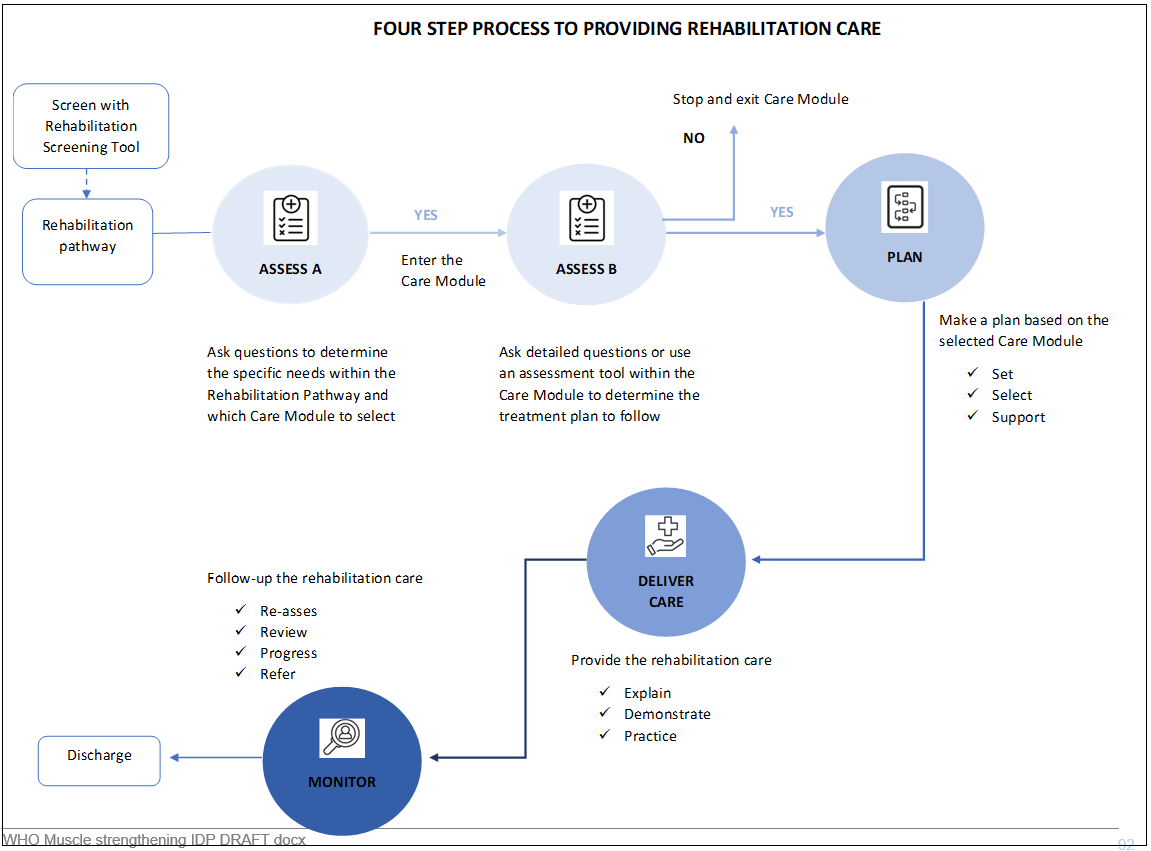Steps to providing muscle strengthening exercises
Steps
Step One – Assess
- Assess 1
- Assess 2
Step Two – Plan
- Set
- Select
- Support
Step Three – Deliver care
- Explain
- Demonstrate
- Practice
Step Four – Monitor
- Reassess
- Review
- Progress
- Refer
Remember the four steps in providing rehabilitation interventions?
Do a recap by going through the diagram below
The steps are discussed in detail in lesson 2

Summary
- Muscle strength allows us to do everyday activities
- Muscle strengthening exercises have many physical and psychological benefits
- Muscle strengthening exercises can benefit many different people and many different health conditions
- The Medical Research Council Muscle Power Test is commonly used to assess muscle strength
- The Medical Research Council Muscle Power Test requires no equipment and allows the examiner to grade muscle strength on a scale of 0 to 5
- Grade 0-2 on the MRC muscle power test require the person to be assessed in a position where gravity is eliminated
- Movements can be defined as individual, when only requiring mainly one muscle group, or functional, when requiring multiple muscle groups and replicate movements that are performed in everyday life
- Movements can be performed passively, where another person performs the movement for a
- person, active-assisted, where the movement is performed partly by the person and partly by another person, object or another body part, or actively, where the person performs the movement independently
- The subjective assessment and observation should be used to guide where to begin muscle strength assessment
- Being able to identify the movements used in everyday activities helps to be able to plan assessment and achieve rehabilitation goals
- When providing muscle strengthening exercises, remember the four steps in providing rehabilitation interventions; assess, plan, deliver care and monitor
You have completed
lesson 1!
Lesson 1 quiz
Please complete the following quiz before moving on to the next lesson:
![]() Quiz
Quiz
1. Which of the following are benefits of muscle strengthening?
- a. Improved self-esteem
- b. Improved balance
- c. Lowered blood pressure
- d. Increased bone density
- e. All of the above
If you selected e, you are correct.
Answers a-d are all benefits of muscle strengthening.
2. What is the correct definition for ‘repetitions’?
- a. The number of times you repeat the exercise in a set.
- b. The amount of weight you are able to actively perform a movement against.
- c. Overall exercise plan outlining all exercises, repetitions, sets and dosage.
- d. A group of repetitions performed without resting.
If you selected a, you are correct.
Answer b is the definition of ‘resistance’.
Answer c is the definition of ‘exercise plan’.
Answer d is the definition of ‘set’
3. True of false, when assessing muscle strength, you must start by assessing for grade 0/5 strength?
- a. True
- b. False
If you selected b, you are correct.
You should start assessing muscle strength guided by the observations you have made during the subjective assessment or when assessing range of motion.
4. How do you ask or assist a person to perform a movement in a ‘gravity eliminated’ position mean?
- a. Ask or assist the person to perform the movement against gravity
- b. Ask or assist the person to perform the movement in a supine position
- c. Ask or assist the person to perform the movement in a position where they do not have to move against gravity
- d. Ask or assist the person to perform the movement in outer space
If you selected c, you are correct.
Performing movements in a ‘gravity eliminated’ position means positioning the person so that they are not moving against gravity.
5. If a person is having trouble bending their knee when walking, what is the most important movement to assess?
- a. Hip flexion
- b. Knee flexion
- c. Hip extension
- d. Knee extension
If you selected b, you are correct.
If someone is having trouble bending their knee, you should assess knee flexion strength. You may also look to assess all of the other movements listed as well.
6. Which of the following people may benefit from muscle strengthening exercises?
- a. People with poor balance
- b. People diagnosed with osteoarthritis
- c. People diagnosed with COPD
- d. People looking to reduce or maintain weight
- e. All of the above
If you selected e, you are correct.
All of these people may benefit from muscle strengthening exercises.
7. True or false: A person with chronic obstructive pulmonary disease should not perform muscle strengthening exercises?
- a. True
- b. False
If you selected b, you are correct.
Muscle strengthening exercises are suitable for people with COPD and can help to improve their function, endurance and ability to perform everyday activities.
8. True or false: Muscle strengthening exercises are not suitable for people with osteoarthritis.
- a. True
- b. False
If you selected b, you are correct.
Muscle strengthening exercises are suitable for people with osteoarthritis and can help to improve their function, endurance and ability to perform everyday activities.
